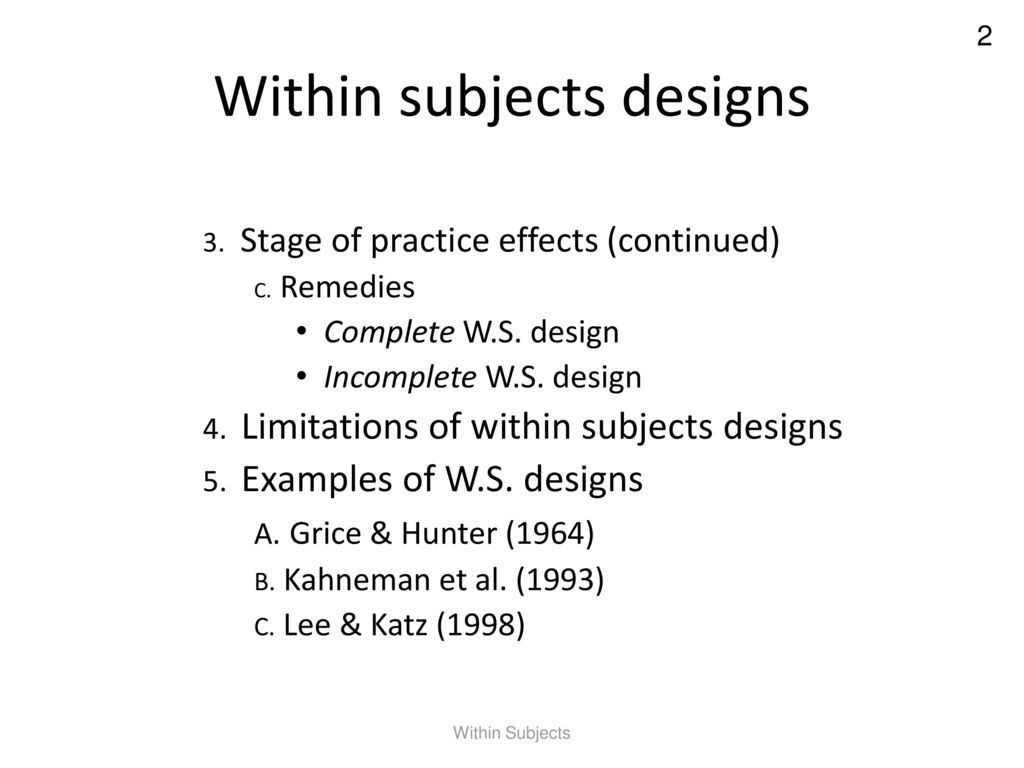example of within subjects design
Overview The within-subjects or repeated measures or paired-samples t-test is a very common statistical method used to compare mean differences between two dependent groups. Emilys study is an example of a within-subjects design which is sometimes called a repeated measures design.

Within Subjects Designs Ppt Download
Within-subjects studies are typically used for longitudinal studies as researchers can assess changes within the same group of subjects over an extended period of time.

. This type of experimental design is when one set of participants are tested more than. The within-subjects design but not the between-subjects design allows for random assignment of participants to the levels of an independent variable. For example math achievement of students before and after an.
This problem is a special case of a split-plot or a between-by-within subjects design. More than 1 IV. Data collection for within-subjects design sessions takes longer because each participant is taking part in multiple treatment conditions.
Between-subjects versus within-subjects design Youre planning to study whether taking a nap your independent variable after a learning session can improve test scores your dependent variable. The researchers in the crudest form of the test will give all of the participants the placebo for a time and monitor the results. The withinsubjects ANOVA is appropriate for repeated - measures designs eg pretest-posttest designs within-subjects experimental designs matched designs or multiple measures.
You can use either a between-subjects or a within-subjects design. For example Lou has two groups of participants one in the 50 degree. Within-Subjects Designs Basic Within-Subjects Repeated-Measures Design.
This type of design is also referred to as a repeated measures design. For example if you were testing participants in a doctors waiting room or shoppers in line at a grocery store you might not have enough time to test each participant in all conditions and therefore would. If you use a between-subjects design you would split your sample into two groups of participants.
You are studying the effects of time the independent variable on perceptions of the pandemic and coronavirus the dependent variable. Here are a few examples of between-subjects design testing sessions categorized by the industry conducting the tests. Due to the nature of the research question your participant design will be a within-subject design.
Another common example of a within-subjects design is medical testing where researchers try to establish whether a drug is effective or whether a placebo effect is in order. First each subject is observed repeatedly in different conditions and the same measure is used as the. 2 So one group of participants would receive one treatment while another group would receive a different treatment.
For example if you are conducting a taste test and the same participants drink several flavors rating their reaction each time then flavor is a within-subjects factor and your study is said to use a within-subjects design. If a within-subjects design would be difficult or impossible to carry out then you should consider a between-subjects design instead. A within-subjects design refers to a study design where two or more measures are obtained from a sample of subjects.
In a between-subjects design people are only assigned to a single treatment. Advantages Disadvantages of Wi-Subjects Designs. Within-subjects design over time Consider yourself a social researcher.
Like in the previous example your experiment will most likely be composed of single or multiple reading tasks and your stimuli will be text excerpts. This is different than the between-subjects t-test because individuals are in both of the two comparison groups. Examples of within-subjects design Example 1.
A within-subjects or repeated-measures design is an experimental design where all the participants receive every level of the treatment ie every independent variable. For example assume a psychiatrist is looking for new medication to treat patients with Obsessive-Compulsive Disorder OCD. Using a within-subjects design.
The within-subjects design requires a larger sample size to detect an effect compared to the between-subjects design. The differences between the two groups would then be compared. Recall that another label for independent variable is factor.
Three common circumstances lead to within-subjects designs. Within-subjects ANOVA however is more general than the paired correlated-scores t-test in that it also can be used with more than two repeated measures. This within-subjects design can be compared to what is known as a between-subjects design.
Between-Subjects Within-Subjects and Mixed Designs page 1 Overview This reading will discuss the differences between between-subjects and within-subjects independent variables and will discuss some issues that are specific to studies that use each type. For example one group might receive an experimental drug at four different times a control group receives a placebo and the goal is to compare the groups at time 1 at time 2 at time 3 and at time 4. Explicit Memory in Amnesics vs.
Both Within- Between-S IVs. Examples of between-subjects design. If your study involves both a within-subjects factor and a between-subjects factor it is said to be a mixed design.
For example in a candy taste test the researcher would want every participant to taste and rate each type of candy. One common experimental design method is a between-subjects design which is when two or more separate groups are compared.